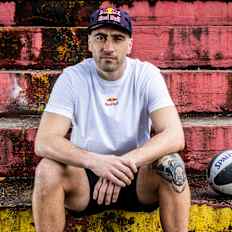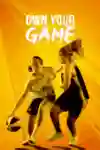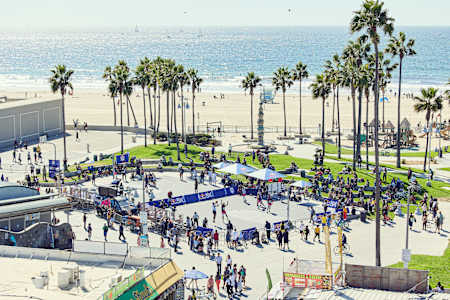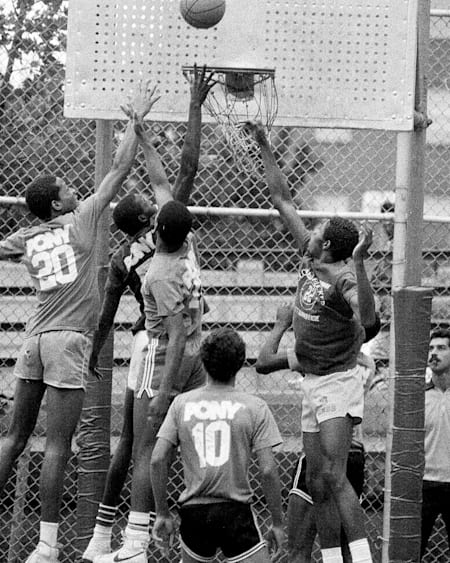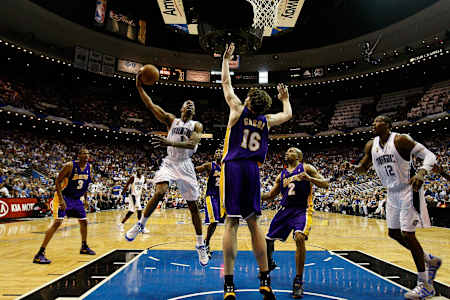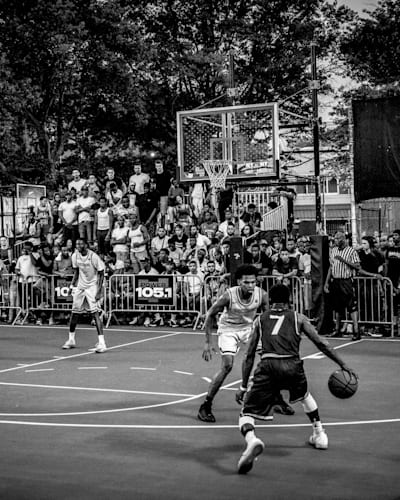
Basketball
What is Streetball? All you need to know about basketball's purest form
Discover everything you need to know about streetball, and learn how this tough, tricky basketball variant from the streets of New York continues to shape professional sports.
01
The history of streetball
In New York in the mid 1940s, Holcombe L Rucker, a teacher and playground director for the city Parks Department, began organising basketball tournaments around his local area in Harlem. Popularity of these grew and, in 1950, he founded the New York City pro-am basketball tournament. By 1954, his competitions had found a permanent home, taking place regularly at a small park named PS 156, situated between 155th Street and Frederick Douglass Boulevard. These days, that park is now regarded as the most famous streetball court in the world, due to the amount of ABA and NBA talent that it spawned. Though Rucker died in 1965, the legacy of his tournaments has continued to resonate. In 1974, at the request of many players who started out on the court there, PS 156 was renamed Rucker Park by the city of New York.

23 min
Inside the rise of Toronto basketball
Meet basketball pioneers who've grown the game and get to know a group of young hopefuls chasing their dreams.
In 1982, another influential streetball figure came to the fore, as a young rapper named Greg Marius began organising tournaments between local hip-hop crews. Marius's tournaments at Rucker Park became the now-famous summer tournament, the Entertainers Basketball Classic. In this tournament, streetball legends and seasoned NBA superstars collide: players like Wilt Chamberlain, Kareem Abdul-Jabbar, Dr J, Allen Iverson, Kobe Bryant, LeBron James, John Wall and many more have played in front of an audience watching from fences, rooftops and windows.
In the late '90s, streetball hopped into the mainstream worldwide with the launch of the AND1 Mixtape Tour in 1998. The AND1 Mixtape Tour changed the phenomenon and perception of the sport as it was limited in the USA until then. Suddenly, streetball legends like Skip 2 My Lou, Hot Sauce and The Professor were showing their crazy basketball tricks and amazing dunks on ESPN and delighting a worldwide audience.
TV shows like "City Slam" and films like "Above the Rim," "White Men Can't Jump" and the 2013 streetball documentary, "Doin' It in the Park," delivered streetball and its players to a mainstream audience.
02
Streetball: What is it?
Born in the parks and streets of New York, streetball is a variation of basketball that features a less formal structure than the traditional sport. The sport encourages players to showcase their skills while implementing a relaxed approach to the conventional rules of basketball. The big difference is there is no referee in streetball (although referees are sometimes used in large tournaments). Disputes on how to score points are settled between players.
When playing with one basket, streetball can be played with anywhere from eight people (four on each side) to two people(one on each side). However, four on each side is rare as it quickly becomes too crowded when playing on a basket. If ten people of a similar level meet on an outdoor or streetball court, five people on each side can play between two baskets.
The counting method in streetball also differs from the counting method of traditional basketball. Throws from beyond the three-point line count as two points instead of three points in streetball. Throws inside the three-point line count as one instead of two points.
In addition to team play, the tight, one-on-one nature of streetball means it's extremely reliant on players' individual skills. Players will often show off their dribbling skills and look to bring opponents down with various crossovers before scoring. In streetball, the more impressive your style, the more respect you earn.
Streetball games are won by the team that reaches a pre-agreed points total first. Usually, teams will agree on a first-to-11 points system. Depending on how busy the court is, individual games can last longer, continuing up to 15 or 21 points. At busier times, a winning score of 7 points may be decided upon.
03
The most important streetball rules and terms
Since the rules of streetball are made by the players themselves, each outdoor court has its own rules. However, some basic rules apply everywhere without prior agreement:
- To determine which team has possession of the ball first, a three-pointer is thrown: if it goes in, the team of the thrower has the ball, if the throw misses, the other team has the first attack.
- Every attack after a dead ball (out/foul/successful basket, etc.) starts with a 'check' outside the three-point line - i.e. a short pass by the attacker to their defender, who immediately plays the ball back.
- A hit from beyond the three-point line counts for two points in streetball, a throw inside the three-point line counts for one point.
- Because there is no referee, the attacker calls the fouls. The unspoken rule is to call only real fouls and not to be too soft. To underline this approach, people sometimes jokingly say 'no blood, no foul'. The bottom line is that every player should feel that their honour is being taken and that they are being honest - with themselves and with their opponents - when announcing fouls.
- In case of a foul, there is no free throw, but possession of the ball for the team of the fouled player.
- After a successful basket, the attacking team gets the ball again, according to the motto: 'make it, take it.' Whoever makes the basket gets the ball.
- The stepping and dribbling rules are the same as in organised 5-on-5 basketball, although they are not interpreted and enforced quite as strictly. Especially when dribbling, there is much more freedom in streetball.
04
The coolest streetball events

26 min
Own Your Game
Relive the fastest 3on3 basketball tournament's world final through the eyes of the players.
- Red Bull Half Court: Since 2021, Red Bull has been looking for the world's best 3-on-3 streetballers as part of the Red Bull Half Court 3x3 streetball tournament. With stops in 20 countries, Red Bull Half Court is a truly global streetball tournament.
- FIBA 3x3 World Tour: Comparable to the PGA Tour in golf or the WSL in surfing, the FIBA 3x3 World Tour is the highest level of play in the 3x3 basketball world. From May to December, the qualified teams collect points in a tournament format at spectacular stops from Japan to France. This year it started with the Utsunomiya Opener in Japan on May 14. Finally, the 3x3 World Tour Champion 2022 will be determined at the World Tour Finals in Abu Dhabi on December 9-10.
- FIBA 3x3 Women's Series: The FIBA 3x3 Women's Series is the most prestigious 3-on-3 series in the world. The 2022 tournament began on May 25 and the grand final will take place on September 17-18 in Constanta, Romania.
The 5 most legendary streetballers in the world
- Earl 'The Goat' Manigault: When NBA legend Kareem Abdul-Jabbar was asked to name the best player he had ever played against, he replied simply: "The Goat". Manigault not only had incredible jumping power, but he was also deadly accurate and had incredible 'handles'. His eventful life is recounted in the HBO film Rebound.
- Ed 'Booger' Smith: Booger Smith was a streetball wonderkid. In 1997, aged 17, his point guard skills were already so established on the courts of New York that he was the subject of a streetball documentary, 'Soul in the Hole', and on the cover of Sports Illustrated. Not bad going for someone who was essentially an amateur sportsman. Sadly, though a career in the NBA was within his grasp, personal circumstances meant he never made it to the very top.
- Larry 'Bone Collector' Williams: Born in 1980, and a contemporary of Booger Smith, Bone Collector Williams is a streetball thoroughbred. He learned his skills on the open courts of America - from his birthplace of Tyler, Texas to Southern California, where he grew up, to New York City, where he made his name in Rucker Park. The Bone Collector is especially notorious for his crossovers – which were the source of his nickname, as he was said to be so fast that he regularly broke opponents' ankles – and his formidable trash talking. He is even said to have defeated Allen Iverson once in his prime...
- Rafer 'Skip To My Lou' Alston: ESPN once called Rafer Alston "the most famous streetballer of the modern era." The AND 1 Mixtape Tour alone, which started with him, has inspired streetballers for generations. He is also one of the few true streetballers to have made it to the NBA and played successfully there for several years. After being drafted by the Milwaukee Bucks in 1998, he played for various teams for about 14 years before retiring. Of course, he still pays a visit or two to the open courts of New York.
- Grayson 'The Professor' Boucher: You've probably seen The Professor on YouTube, where he entertains his millions of followers by dressing as Bugs Bunny and pitching up at various basketball courts across America to show amateur players exactly how it's done. He's also guest starred in films including 2008's "Ball Don't Lie" and Adam Sandler's 2022 Netflix film, "Hustle."
Part of this story


